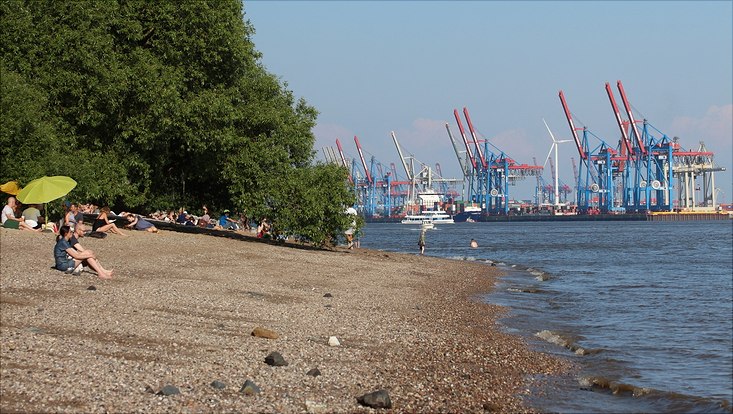The future of the Elbe: less dredging, more flood protection
4 July 2024, by Johannes Pein

Photo: UHH/CEN/T. Wasiliewsk
Canoes, sailboats and freighters drift by, while the surface of the Elbe glitters. At first glance, you can’t see the problems. Hamburg’s harbour is deepened by dredging to allow fully loaded container ships to enter. But this costs a lot, produces more CO2 and harms the ecosystem. Is there another way?

Large-scale construction efforts could reduce the silting in the long term. But with what consequences? For me as a modeler, trying to realistically project those consequences was a fascinating challenge. Would a dam in the North Sea be more sensible, or a flooding area in Altes Land? And what effects will these measures produce as climate change progresses? As a member of Universität Hamburg’s Cluster of Excellence for climate research, CLICCS, I examined four options – purely hypothetically, of course – to determine which held the most potential.
Fundamentally speaking, there are two ways to stop the silting in of the harbor. On the one hand, you can reduce the flow of water, which carries sediment into the river. This is done with barriers, which slow the daily tidal wave before it reaches Hamburg, reducing the influx of new sediment in the process. A tidal barrier, installed downriver, or a sea dike off the coast of Cuxhaven could do the trick.
Or you can intensify the low tide, which flushes sediment back out of the river. To do so, you need to provide more room for the tides – which could be done by creating a new flooding area, or polder. Alternatively, an arm of the river previously laid dry, like the old Süderelbe, could be restored for this purpose.
But what would be the effects of each variant? Could there be harmful side-effects? I looked into this question with the aid of a complex computational model. On the basis of the river’s topography, the model can simulate its tide dynamics and estimate how much water reaches the port. I used the model to test each proposed change in turn. At the same time, other calculations offered insights into how the water quality, oxygen content and salinity would be affected.
In a nutshell: we could cut the dredging in half! Whereas we currently have to pump out roughly five million cubic meters of sediment per year and transport it away by ship, by making these changes, we could cut the dredging – depending on the specific solution chosen – by half or even more. In this regard, the polder truly shines; according to the model, it could even remove more sediment from the Elbe than is transported in.
What’s more, all variants would reduce flood risks. In the future, sea levels will rise and flash floods could become more common and intense. But a restored Süderelbe could reduce the flood height by 20 centimeters by 2100, while a sea dike could cut it by half a meter, and a polder could do so by an entire meter.
When it comes to improving water quality, however, the barrier and sea dike are poorly suited candidates, as they block the tides. But the water needs to be mixed regularly to keep the river from “tipping over” in the summer. In addition, a barrier would further increase salinity – which would be bad news for ecosystems, agriculture and industry alike.
The restored Süderelbe and polder options are ideally suited for coping with climate change. Both options use the natural river courses and rely on nature. Needless to say, such major changes need to take into account a range of perspectives and be developed together with the local populace. But if we just sit and wait, in the worst case the Elbe will simply claim the areas it needs.
More information
Dr. Johannes Pein is a modeler and an expert on currents. He pursues research at the Helmholtz-Zentrum Hereon and Universität Hamburg’s Cluster of Excellence for climate research, CLICCS.
Newspaper: This article was first published as a guest article in the Hamburger Abendblatt as part of a monthly series on climate research. Find all articles of the series here. Find all articles of the series here.


